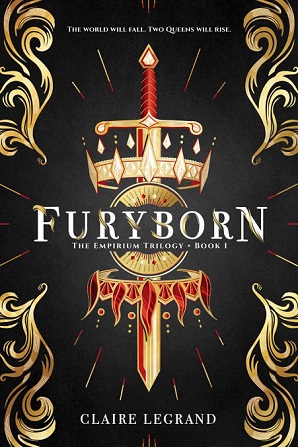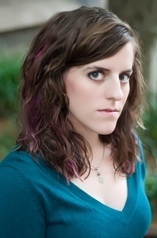- Categories:
A Q&A With the Author of “Furyborn,” a Summer Kids’ Indie Next List Top Pick [3]
- By Liz Button [4]
Booksellers have chosen Furyborn (Sourcebooks Fire), the first book in Claire Legrand’s Empirium Trilogy, as a top pick on the Summer 2018 Kids’ Indie Next List [5].
 Book one of this young adult epic fantasy trilogy debuted on the New York Times bestseller list in May. Furyborn [6] introduces Rielle, who, according to a prophecy in her world, is one of a pair of queens who will decide the world’s fate: a queen of light, and a queen of blood. One thousand years later, Eliana, a bounty hunter for the ruthless and ever-expanding ruling empire, teams up with a group of rebels who show her the other side of the battle at hand. As a cosmic war rages across thousands of years, Rielle and Eliana’s stories will ultimately intersect and determine the destiny of the human race.
Book one of this young adult epic fantasy trilogy debuted on the New York Times bestseller list in May. Furyborn [6] introduces Rielle, who, according to a prophecy in her world, is one of a pair of queens who will decide the world’s fate: a queen of light, and a queen of blood. One thousand years later, Eliana, a bounty hunter for the ruthless and ever-expanding ruling empire, teams up with a group of rebels who show her the other side of the battle at hand. As a cosmic war rages across thousands of years, Rielle and Eliana’s stories will ultimately intersect and determine the destiny of the human race.
“Furyborn is exactly the kind of ambitious, well-written YA high fantasy that I’ve been looking for,” said Cristina Russell of Books & Books [7] in Coral Gables, Florida. “This novel is female-focused and driven, with girls who are strong, powerful, pissed off, damaged, unabashedly sexual, and in control. The writing is so beautiful, I found myself re-reading sentences simply for the pleasure of it. It’s a story that is complex, compelling, and carefully crafted. Claire Legrand is a jewel. I can’t wait for the next installment.”
Legrand [8] is a librarian living in New Jersey and the author of many books for young readers, including The Cavendish Home for Boys and Girls; Some Kind of Happiness; and Winterspell, her re-telling of “The Nutcracker” (all Simon & Schuster Books for Young Readers). Her next book, Sawkill Girls (Katherine Tegen Books), a queer young adult horror novel, will be released October 2.
Here, BTW speaks with Legrand about the first book in her new Empirium Trilogy [9].
Bookselling This Week: This huge universe that you’ve created is a great example of “world-building,” in YA parlance. How did you first get the idea for this book and this world?

Claire Legrand: I’ve actually been working on this story, the entire trilogy, for 14 years. I came up with the idea right after I graduated from high school. I was daydreaming and listening to music; I used to be an orchestral trumpet player, and so music has always been a huge part of my life and a huge part of my writing process as well.
The album was Howard Shore’s score for Lord of the Rings: Return of the King and I had this vision of a young woman who was very powerful, but very sad. She was surrounded by a field of fire and she was about to make a choice that would change not only her life but the life of everyone around her. I started asking myself questions about her: who she was, what this power she had was, why she had it, who did she love, who did she hate. As I started answering those questions, the rest of the story grew up around there.
BTW: The world you created in your book contains intricate geographical, political, and cultural details. Were you influenced by fantasy series like A Song of Ice and Fire and The Lord of the Rings and their unique, three-dimensional worlds?
CL: I’m a big fan of both of those series so you can definitely, I think, see the influence of those works in my own. I did try to infuse my story with more women and more people of color than may have appeared in Lord of the Rings and even Game of Thrones (which is slightly more inclusive than Lord of the Rings), so I tried to put my own spin on the story in a lot of ways.
In the first draft of this, which I wrote years and years ago, the story actually took place in our world, so in that iteration, I was drawing upon actual real-world geography and languages and cultures. Over the years, it evolved into a complete second world fantasy like Lord of the Rings or Game of Thrones, but you can still see echoes of that original version. For example, for Celdaria, which is Rielle’s kingdom, I draw a lot on the French language to help me name the cities and the character names. In Kirvaya, I drew upon a lot of Russian language to come up with the various names in that kingdom. And then some of the kingdoms are based on languages and worlds of my own creation. So it’s a combination of those two things.
BTW: One of the continuing themes in Furyborn is that of good and evil, as well as how our choices define us as human beings. Did you have this sort of ethical framework in mind as you were writing the book?
CL: Yes, absolutely. There’s a prophecy in Furyborn that is sort of the basis of the world’s religion that says two queens will rise, one of blood, one of light; one has the power to save the world and one has the power to destroy it. So there’s a good queen and a bad queen, and one of the things I’m exploring in this trilogy, and I particularly get into it in book two, is the idea that it is dangerous to say that anyone is all good or all bad; trying to force people into those narrow categories is unfair and unkind, and, in the case of Rielle, as it’s at hinted in the prologue, it can even be dangerous and tragic.
Both of my protagonists have light and dark inside them; they are messy and they make mistakes and sometimes they are selfish and sometimes they are selfless, sometimes they are great and sometimes they’re cowardly. They’re incredibly flawed, and despite those flaws or perhaps because of them, they are able to do extraordinary things. I wanted my readers, but especially young girls, to see them and think, oh wow, these characters are full of messiness just like I am and yet they are still these extraordinary young women, so I can be extraordinary as well.
BTW: Was this trilogy originally one long book that you’ve split into three books, or are you continuously writing the next installments?
CL: I’ve always imagined this story as a trilogy. I just always liked the structure of the three parts; there’s something very satisfying about three books reflecting the beginning, middle, and end of a story. Working on this story for so long and finishing book two recently, I was excited to finally be able to write these scenes that I had been thinking about for years and years.
As a child, I loved trilogies both in books and in movies. I really like both of the Stars Wars trilogies, including the prequels — I know there are a lot of haters out there — and the Lord of the Rings trilogy. His Dark Materials trilogy by Philip Pullman is one of my favorite series of all time. I also really like the Graceling trilogy by Kristin Cashore.
BTW: The concept of “the Empirium” seems similar to the mysterious substance of “Dust” in The Golden Compass and His Dark Materials. Will we find out what the Empirium is as the trilogy continues?
CL: Yes, you’ll definitely find out more about the Empirium in books two and three. In the Star Wars prequels, one of the things that I did not like is that they tried to explain the nitty-gritty workings of the Force; I much prefer the idea of the Force as this mystical, powerful thing that we didn’t quite understand, much in the same way that Philip Pullman wrote about “Dust.” This way it allows the reader to think beyond the end of the story and come up with their own theories for what it is. So I will answer some questions about the Empirium but not all because that’s the way I prefer to read stories, and so that’s the way I want to write this one.
BTW: Do you still play music when you write or brainstorm, the way this trilogy was first inspired?
CL: It depends on what I’m writing and my mood that day and where I am physically, if I’m at home or the library or a coffee shop, but I do write a lot to music. I listen primarily to film scores and television scores. For example, I just finished writing book two and I wrote much of it to the score for the Netflix show The Crown, but I’ve also listened to a lot of Game of Thrones and a lot of different scores by Bear McCreary, who did the score for the Battlestar Galactica reboot.
I also listen to music a lot when I’m brainstorming. I have extensive playlists for each of my books that I put together as I’m writing, and the playlists are made up of film scores and follow the action of the book from start to finish. I actually have those playlists on Spotify [10] and they’re available to people; I have links to them on my website.